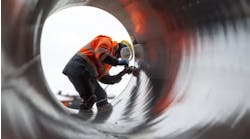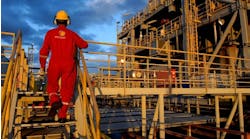First Barents Sea development also under consideration
Nick Terdre
Contributing Editor
- Norsk Hydro: Field Developments in the Planning Stage [238,656 bytes]
- Norsk Hydro's Fram and Gjoea Fields, which both lie to the north of Troll, are to be developed separately using semisubmersible production platforms [118,524 bytes].
- Snoehvit could come on stream in the early years of the next century, making it the first Barents Sea field to be developed [48,004 bytes].
Hydro already has a number of approved developments approaching start-up: Visund and Oseberg East this year, the second phase of the Troll Oil development in 1999, and Oseberg South and Oseberg Gas in 2000.
Still to be approved are Grane and Fram. These are scheduled by Hydro for 2001, but may be pushed back to 2002 by the official slowdown. Startup on Gjoea is currently planned for 2002, while Snoehvit, the first development in the Barents Sea, could come on stream in 2003.
At the same time there will be further developments in the Oseberg area. A platform development is planned for the "A" structure to the south-west of the main field, which holds an estimated 30-35 bcm of gas and could be brought on stream in 2002. Later, up to eight satellite pools are planned to be produced using subsea facilities.
The facilities on Oseberg D, the new gas platform, will be brought into operation in late 1999 - a year before gas export begins - to dry the gas and send the liquid components to Hydro's Sture terminal where they will be processed into propane and butane. A NKr 1.4 billion upgrade is currently under way at the terminal.
Oseberg gas will be exported through a new pipeline into the Statpipe system via Heimdal. Under the aegis of the Heimdal 2000 project, Hydro is now attempting to secure the future of the Heimdal infrastructure as the hub for future gas developments in that area.
There are a number of small satellite fields such as Skirne and Vale, but to make the project fly, Hydro is negotiating for supplies from a significant field such as Huldra or Kvitebjoern. This would entail the installation of a riser platform alongside the existing Heimdal processing platform, which would itself require an upgrade. In the event of new gas sales to the UK, a new export connection could be made through a link from Heimdal into the Norwegian Frigg-St Fergus trunkline.
Outlying fields
Grane is a heavy oil field - 19! API crude - on which Hydro envisages drilling some 40 horizontal production wells. Another 8-10 injection wells will be required, and injection gas will be imported from Heimdal. The development, which will require separate platforms for drilling and processing, will cost NKr 12-15 billion.A development plan for Fram, which lies to the north of Troll, is due to be submitted in late summer and should be approved in early 1999. An appraisal well is planned for this spring which could lead to a reserves upgrade.
A semisubmersible production platform with drilling capability will be used. Sixteen wells are planned, comprising 11 producers, five gas injectors and one water injector. Oil will be exported by pipeline to a link on the Troll C pipeline to shore, and gas reinjected in the first six years or so. Power for the platform will be provided by cable from shore.
A well is planned before mid-year for Gjoea, which lies a short distance to the north of Fram, in hopes of raising reserves to around 190 million bbl of oil and 40-45 bcm of gas. Here again, a semi with drilling facilities is planned, serving up to 15 wells. Oil will be exported by pipeline, either directly to Sture or into the Troll C export line.
The project presenting the most novel challenges is Snoehvit. The Barents Sea field lies some 140 km from shore and in addition to large gas reserves contains an estimated 95 million bbl of recoverable oil in layers 14-16 meters thick. Development planning takes into account the nearby Albatross and Askeladd fields. Recoverable gas from the three fields is an estimated 200 bcm.
Altogether, seven licences are involved - six in which Hydro has a stake, and two that it operates. Although Statoil will operate the development, Hydro is expected to play a key role in production of the thin oil layers using its experience from the development of Troll oil.
An appraisal well is planned for Snoehvit this summer, to better delineate the oil reserves in the west of the field. Then the schedule, which Hydro describes as ambitious, calls for a plan of production (PDO) submission in late 1999 and startup in 2003. Subsea wells tied back to shore and a production ship have been considered, but a semisub platform with drilling capability is considered to give the best production flexibility and ultimate recoverability.
Gas production will continue over some 25 years, with a plateau rate of 5.5 bcm/year, but oil production will last only 10-12 years. Estimated capex of NKr 17-20 billion includes the cost of an LNG plant at Melkoeya. Carbon dioxide will be reinjected.
Copyright 1998 Oil & Gas Journal. All Rights Reserved.


